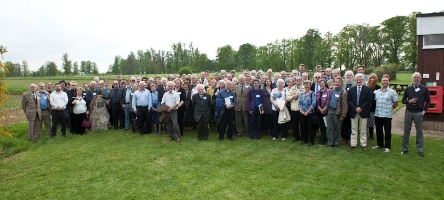Death's Head Hawk Moth courtesy of Trevor James
On 29th April, the Rothamsted Insect Survey (RIS) celebrated its 50th birthday. Current and past staff, volunteers, funders and dignitaries participated in a day of reminiscing and looking forward.
Ian Woiwod, former Head of the RIS traced the origins of the survey back to the Egyptian pyramids. Richard Harrington outlined the uses to which the suction-trap network is put today and Mark Stevens, Lead Scientist of the British Beet Research Organisation, highlighted the importance of the RIS to the agricultural industry.
There were plenty of posters and artefacts to view at lunch time, although renewing acquaintances and making new ones took priority. Ian Tillotson, the survey's longest serving volunteer, who has clocked up 46 years of light-trap operation and around 200 trap-years of identification, had the honour of cutting the celebratory cake. Volunteers are the cornerstone of the RIS and each of those present received a certificate of thanks, as did all others who had ever emptied a light-trap or suction-trap.
Tim Benton, University of Leeds and UK Government Adviser on food security, opened the afternoon session by describing how the RIS contributes to knowledge aiding ecosystem service provision and how much more information is locked up in the samples waiting to get out. Chris Shortall, RIS Chief Ecologist, gave an update on the uses of the light-trap network and Martin Warren, Chief Executive of Butterfly Conservation (BC), outlined collaborations between BC and RIS which have led to an improved understanding of changes in moth abundance and pointed to mitigation options.
You can visit the website for the various presentations and photographers taken during the celebrations.
A commemorative plaque was unveiled by Robin Taylor (Texas A&M), son of RIS founder Roy, helped by Harpenden Town Mayor Councillor Rosemary Farmer.

